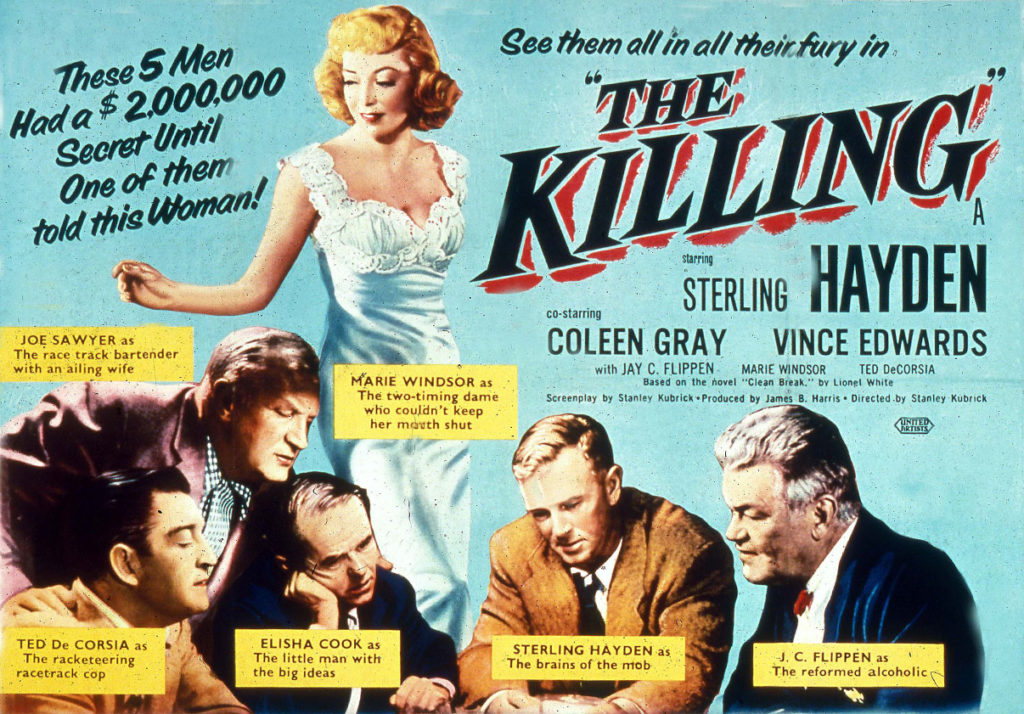
Adapted by Stanley Kubrick and Jim Thompson from the pulp novel by Lionel White, The Killing is classic noir. The plot is about an expertly planned racetrack heist that goes spectacularly wrong because the weak link in the chain of confederates is married to a two-timing frail. A cast of noir stalwarts under Kubrick’s direction brings this story to life. Later Kubrick movies such as 2001 and A Clockwork Orange are more ambitious undertakings, but many of us with noir in our bones have a special affection for The Killing, a taut, black-and-white depiction of futility and failure.
Just out of prison, Johnny Clay is tall, tough, taciturn, and as decent a guy as you could want in a thief—a role Sterling Hayden was born to play. He has planned the robbery with a chess player’s precision. An inside job, it requires the contributions of a pay-window cashier named George (Elisha Cook Jr.) and a track bartender. Johnny has also recruited Randy (Ted de Corsia), a crooked cop, who drives solo in his prowl car; Nikki, a sharpshooter (played with great nastiness by Timothy Carey); and Maurice, a muscle man (Kola Kwariani, a Georgian wrestler with whom Kubrick played chess).
Nikki must shoot Black Lightning, the favorite in the high-stakes race of the day, just before the colt reaches the backstretch of the track. At the same time, Maurice will pick a fight at the bar. You need 10 men to hold Maurice down, and so, amid the chaos, no one notices the cashier when he unlocks the door marked “NO ADMITTANCE,” behind which men count and stash the day’s take. The diversions give Johnny time enough to walk in, don a mask, brandish a submachine gun, and collect the dough in a duffel bag, which he then tosses out the window … for Randy to pick up and drive away in his cop car. A perfect crime.
Kubrick starts and restarts the story, shifting points of view, reverting each time to the track announcer’s call of the $100,000-added Lansdowne Stakes. The marksman’s story features a chilling scene between Nikki and a black racetrack employee played by James Edwards. The narrative throughout is advanced by voiceover, a matter-of-fact male voice of authority, accentuating the suspense.
The novel’s original title was Clean Break. Elisha Cook, Jr., so memorable as the humiliated gunsel in The Maltese Falcon and as brave, lovesick Harry Jones in The Big Sleep, is outstanding as George the cashier, a man who, in Lionel White’s novel, is said to be “crazy about his wife” but “not completely blind to her character.” He knows, too, that “he himself had failed as a husband and failed as a man.”
In short, he is the archetypal noir loser, married to Sherry (Marie Windsor), who is discontented, fickle, frustrated, and doomed. When George confides that in the next few days he will have a lot of money, she says, with practiced cruelty, “Did you put the right address on the envelope when you sent it to the North Pole?” Sherry gets George to reveal the gang’s plan.
Everything goes right until the guys gather to split the proceeds. Sherry has spilled the beans to her handsome boyfriend Val (Vince Edwards). Val and a henchman barge in to steal the dough, and in the ensuing shootout all are killed except George, who is badly wounded but has enough vitality left to stumble home and shoot Sherry before he expires. “It isn’t fair,” she says, making the cinematic most of the moment. “I never had anyone but you, not a real husband, not even a man.”
Having transferred the loot to the biggest suitcase he could buy, Johnny Clay arrives at the scene 15 minutes too late. Seeing George stumble down the front stairs, Johnny puts two and two together and drives away with the sound of sirens in his ears. He and girlfriend Fay (Coleen Gray) hightail it to the airport.
The Killing ends with the greatest money shot in the movies, its nearest competition being the shower of love bestowed on James Stewart on Christmas Eve at the end of It’s A Wonderful Life. Johnny and Fay are at the airport about to board a flight to Boston and freedom. He doesn’t want to let go of the suitcase, but it is too big for the overhead compartment, so he reluctantly yields it. He and Fay watch the suitcase totter atop the checked luggage in the cart taking it from terminal to plane. When a spectator’s dog runs into the cart’s path, the driver swerves, and the suitcase falls off. It pops opens, and the money flies around like snow in a swirling wind.
The set-up has been executed perfectly and yet, because of a stray event, a tiny happenstance, all is for naught—all the blood spilled, all the careful calculation.
Johnny Clay does not survive in the novel. On the last page, two bullets from George’s gun make a “peculiar, plopping sound” as they enter Johnny’s stomach. Under his elbow is a folded newspaper, headlined “Race Track Bandit / Makes Clean Break / With Two Million.” The novel’s original title was Clean Break.
The movie’s ending is even better. Two million bucks in small bills go up in a whirlwind, and the bandit has not only lost the cash but has also unmasked himself as the culprit. Dazed, helpless, Johnny and Fay retreat and try to hail a taxi. They are standing by the airport’s front doors as two armed plainclothes cops walk menacingly toward them. The look on Sterling Hayden’s face is unforgettable.
Fay: “Johnny, you’ve got to run.”
Johnny: “Ah … what’s the difference?”
This exchange, which ends the movie, could stand as an epitaph for all of noir.

